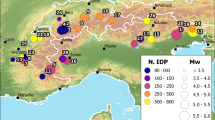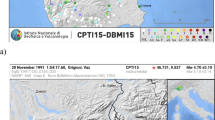Abstract
In the framework of the SIGMA project, a study was launched to develop a parametric earthquake catalog for the historical period, covering the metropolitan territory and calibrated in Mw. A set of candidate calibration events was selected corresponding to earthquakes felt over a part of the French metropolitan territory, which are fairly well documented both in terms of macroseismic intensity distributions (SisFrance BRGM-EDF-IRSN) and magnitude estimates. The detailed analysis of the macroseismic data led us to retain only 30 events out of 65 with Mw ranging from 3.6 to 5.8. In order to supplement the dataset with data from larger magnitude events, Italian earthquakes were also considered (11 events posterior to 1900 with Mw ≥ 6.0 out of 15 in total), using both the DBMI11 macroseismic database (Locati et al. in Seismol Resour Lett 85(3):727–734, 2014) and the parametric information from the CPTI11 (Rovida et al. in CPTI11, la versione 2011 del Catalogo Parametrico dei Terremoti Italiani Istituto Nazionale di Geofisica et Vulcanologia, Milano, Bologna, 2011. https://doi.org/10.6092/ingv.it-cpti11). To avoid introducing bias related to the differences in terms of intensity scales (MSK vs. MCS), only intensities smaller than or equal to VII were considered (Traversa et al. in On the use of cross-border macroseismic data to improve the estimation of past earthquakes seismological parameters, 2014). Mw and depth metadata were defined according to the Si-Hex catalogue (Cara et al. in Bull Soc Géol Fr 186:3–19, 2015. https://doi.org/10.2113/qssqfbull.186.1.3), published information, and to the specific worked conducted within SIGMA related to early instrumental recordings (Benjumea et al. in Study of instrumented earthquakes that occurred during the first part of the 20th century (1905–1962), 2015). For the depth estimates, we also performed a macroseismic analysis to evaluate the range of plausible estimates and check the consistency of the solutions. Uncertainties on the metadata related to the calibration earthquakes were evaluated using the range of available alternative estimates. The intensity attenuation models were developed using a one-step maximum likelihood scheme. Several mathematical formulations and sub-datasets were considered to evaluate the robustness of the results (similarly to Baumont and Scotti in Accounting for data and modeling uncertainties in empirical macroseismic predictive equations (EMPEs). Towards “European” EMPEs based on SISFRANCE, DBMI, ECOS macroseismic database, 2008). In particular, as the region of interest may be characterized by significant laterally varying attenuation properties (Bakun and Scotti in Geophys J Int 164:596–610, 2006; Gasperini in Bull Seismol Soc Am 91:826–841, 2001), we introduced regional attenuation terms to account for this variability. Two zonation schemes were tested, one at the national scale (France/Italy), another at the regional scale based on the studies of Mayor et al. (Bull Earthq Eng, 2017. https://doi.org/10.1007/s10518-017-0124-8) for France and Gasperini (2001) for Italy. Between and within event residuals were analyzed in detail to identify the best models, that is, the ones associated with the best misfit and most limited residual trends with intensity and distance. This analysis led us to select four sets of models for which no significant trend in the between- and within-event residuals is detected. These models are considered to be valid over a wide range of Mw covering ~ 3.5–7.0.












Similar content being viewed by others
References
Ambraseys NN (1985) Intensity attenuation and magnitude-intensity relationships for Northwestern European earthquakes. Earthquake Eng Struct Dyn 13:733–788
Bakun WH, Scotti O (2006) Regional intensity attenuation models for France and the estimation of magnitude and location of historical earthquakes. Geophys J Int 164:596–610
Bakun WH, Wentworth CM (1997) Estimating earthquake location and magnitude from seismic intensity data. Bull Seismol Soc Am 87(6):1502–1521
Baumont D, Scotti O (2006) Towards the development of a common intensity-magnitude attenuation model. On data completeness, binning strategies, depth-attenuation trade-offs and modelling of macroseismic data. Presented at the ECEES conference, Geneve
Baumont D, Scotti O (2008) Accounting for data and modeling uncertainties in Empirical Macroseismic Predictive Equations (EMPEs). Towards “European” EMPEs based on SISFRANCE, DBMI, ECOS macroseismic database. Presented at the APS conference, Manosque
Baumont D, Scotti O (2011) The French Parametric Earthquake Catalogue (FPEC) based on the best events of the SisFrance macroseismic database—version 1.1. (No. rapport IRSN/DEI/2011-012)
Benjumea J, Cara M, Rivera L (2015) Study of instrumented earthquakes that occurred during the first part of the 20th century (1905–1962). SIGMA deliverable D1-129
Cara M, Cansi Y, Schlupp A et al (2015) Si-Hex: a new catalogue of instrumental seismicity for metropolitan France. Bull Soc Géol Fr 186:3–19. https://doi.org/10.2113/qssqfbull.186.1.3
De Rubeis V, Gasparini C, Maramai A, Murru M, Tertulliani A (1992) The uncertainty and ambiguity of isoseismal maps. Earthq Eng Struct Dyn 21(6):509–523
Fäh D, Giardini D, Bay F, Bernardi F, Braunmiller J, Deichmann N, Furrer M, Gantner L, Gislser M, Isenegger D, Jimenez MJ, Kästli P, Koglin R, Masciadri V, Rutz M, Scheidegger C, Schibler R, Schorlemmer D, Schwarz-Zanetti G, Steimen S, Sellami S, Wiemer S, Wössner J (2003) Earthquake Catalogue of Switzerland (ECOS) and the related macroseismic database. Eclogae geol Helv 96:219–236
Gasperini P (2001) The attenuation of seismic intensity in Italy: a bilinear shape indicates the dominance of deep phases at epicentral distances longer than 45 km. Bull Seismol Soc Am 91:826–841
Gasperini P, Bernardini F, Valensise G, Boschi E (1999) Defining seismogenic sources from historical earthquake felt reports. BSSA 89:94–110
Hinzen KG, Oemisch M (2001) Location and magnitude from seismic intensity data of recent and historic earthquakes in the Northern Rhine area, Central Europe. Bull Seismol Soc Am 91(1):40–56
Kövesligethy R (1907) Seismischer Stärkegrad und Intensität der Beben, Gerlands Beitr Geoph Bd 8:24–103
Kunze T (1986) Ausgangsparameter für die Abschätzung der seismischen Gefährdung in Mittel-Europa. Jber Mitt oberrhein Ver Stgt 68:225–240
Levret A, Backe JC, Cushing M (1994) Atlas of macroseismic maps for French earthquakes with their principal characteristics. Nat Hazards 10:19–46
Locati M, Rovida A, Albini P, Stucchi M (2014) The AHEAD portal: a gateway to European historical earthquake data. Seismol Resour Lett 85(3):727–734
Manchuel K, Traversa P, Baumont D, Cara M, Nayman E, Durouchoux C (2017) The French seismic CATalogue (FCAT-17). Bull Earthq Eng. https://doi.org/10.1007/s10518-017-0236-1
Mayor J, Traversa P, Margerin L, Calvet M (2017) Tomography of crustal seismic attenuation in Metropolitan France: implications for seismicity analysis. Bull Earthq Eng. https://doi.org/10.1007/s10518-017-0124-8
Menke W (2012) Geophysical data analysis: discrete inverse theory, 3rd edn. Academic Press, Cambridge
Musson RMW (1996) Determination of parameters for historical British earthquakes. Ann Geof 39:1041–1047
Rovida A, Camassi R, Gasperini P, Stucchi M (2011) CPTI11, la versione 2011 del Catalogo Parametrico dei Terremoti Italiani Istituto Nazionale di Geofisica et Vulcanologia, Milano, Bologna. http://emidius.mi.ingv.it/CPTI. https://doi.org/10.6092/ingv.it-cpti11
SISFRANCE-BRGM-EDF-IRSN/SisFrance (2010) Histoire et caractéristiques des séismes ressentis en France. Last update 01 Mar 2016. http://www.sisfrance.net
Souriau A (2006) Quantifying felt events: a joint analysis of intensities, accelerations and dominant frequencies. J Seismol 10:23–28
Sponheuer W (1960) Methoden zur Herdtiefenbesttimmung in der Makroseismik, Freiberger Forschungsthefte C88. Akademie Verlag, Berlin, p 117
Stucchi M, Rovida A, Gomez Capera AA, Alexandre P, Camelbeeck T, Demircioglu MB, Gasperini P, Kouskouna V, Musson RMW, Radulian M, Sesetyan K, Vilanova S, Baumont D, Bungum H, Fäh D, Lenhardt W, Makropoulos K, Martinez Solares JM, Scotti O, Živcic M, Albini P, Batllo J, Papaioannou C, Tatevossian R, Locati M (2012) The SHARE European Earthquake Catalogue (SHEEC) 1000–1899. J Seismol. https://doi.org/10.1007/s10950-012-9335-2
Tarantola A (2005) Inverse problem theory and methods for Model Parameter estimation. SIAM, Philadelphia, p 342
Traversa P, Manchuel K, Mayor J (2014) On the use of cross-border macroseismic data to improve the estimation of past earthquakes seismological parameters. 2nd ECEES meeting, Istanbul, Turkey
Traversa P, Baumont D, Manchuel K, Nayman E, Durouchoux Ch (2017) Exploration tree approach to estimate historical earthquakes Mw and depth, test cases from the French past seismicity. Bull Earthq Eng. https://doi.org/10.1007/s10518-017-0178-7
Acknowledgements
This work has been carried out within the SIGMA project. It strongly benefited from the comments and the discussions held within the catalog work group and the SIGMA scientific committee meetings. We also acknowledge the researchers from the Dieudonné mathematics laboratory of Nice for the exchanges we had during the initial phase of the work. We are thankful to two anonymous reviewers for their fruitful comments that helped us to improve this manuscript. Finally we would like to thank the data-providers and the seismological observatories for their efforts in collecting and making available earthquake data.
Author information
Authors and Affiliations
Corresponding author
Electronic supplementary material
Below is the link to the electronic supplementary material.
Rights and permissions
About this article
Cite this article
Baumont, D., Manchuel, K., Traversa, P. et al. Intensity predictive attenuation models calibrated in Mw for metropolitan France. Bull Earthquake Eng 16, 2285–2310 (2018). https://doi.org/10.1007/s10518-018-0344-6
Received:
Accepted:
Published:
Issue Date:
DOI: https://doi.org/10.1007/s10518-018-0344-6




